|
General
 2009 Scientific Integrity Calendar - In early 2008, hundreds of Americans entered Science Idol: the Scientific Integrity Editorial Cartoon Contest. UCS worked with some of America’s leading cartoonists to select just twelve finalists—reproduced in the 2009 scientific integrity calendar. 2009 Scientific Integrity Calendar - In early 2008, hundreds of Americans entered Science Idol: the Scientific Integrity Editorial Cartoon Contest. UCS worked with some of America’s leading cartoonists to select just twelve finalists—reproduced in the 2009 scientific integrity calendar.
This calendar shows all 12 of the finalists, one for each month, and features the winning cartoon on the cover. Several additional bonus cartoons are featured throughout the calendar. 2008. $10.00.
Click here to see the 12 winning cartoons featured in the calendar.

 The Consumer's Guide to Effective Environmental Choices: Practical Advice from the Union of Concerned Scientists - The first comprehensive look at the full range of modern consumer activities, identifying those that cause the most environmental damage and those that cause the least. By Michael Brower and Warren Leon. Three Rivers Press, 1999. 304 pp. $15.00. The Consumer's Guide to Effective Environmental Choices: Practical Advice from the Union of Concerned Scientists - The first comprehensive look at the full range of modern consumer activities, identifying those that cause the most environmental damage and those that cause the least. By Michael Brower and Warren Leon. Three Rivers Press, 1999. 304 pp. $15.00.
Read Chapter 1 (html).

 A Scientist's Guide to Talking with the Media A Scientist's Guide to Talking with the Media
Tips and tools scientists can use to communicate complex research to a media audience.
By Richard Hayes and Daniel Grossman.
Rutgers University Press, 2006. 200 pp. $18.95.
Read excerpts from the book (html).

 A Distant Light: Scientists and Public Policy - Essays illuminating the challenges facing scientists who choose to be actively involved in public matters, with keen insights on what it takes to succeed. By Henry W. Kendall. Springer-Verlag, 2000. 336 pp. $49.95. A Distant Light: Scientists and Public Policy - Essays illuminating the challenges facing scientists who choose to be actively involved in public matters, with keen insights on what it takes to succeed. By Henry W. Kendall. Springer-Verlag, 2000. 336 pp. $49.95.

 Keeping the Earth: Religious and Scientific Perspectives on the Environment - Inspirational video with prominent scientists and religious leaders calling on Americans to protect our environment and the diverse species that share it. UCS, 1996. 27 minutes, DVD. $14.95. Keeping the Earth: Religious and Scientific Perspectives on the Environment - Inspirational video with prominent scientists and religious leaders calling on Americans to protect our environment and the diverse species that share it. UCS, 1996. 27 minutes, DVD. $14.95.
 DVD DVD
 DVD with free study guide DVD with free study guide
Global Warming
Climate Change in Pennsylvania: Impacts and Solutions for the Keystone State
 A new report by Union of Concerned Scientists (UCS) and a group of independent scientists and economists provides an in-depth look at the potential consequences of climate change in Pennsylvania and the opportunities available today to reduce heat-trapping emissions in the state. Climate Change in Pennsylvania: Impacts and Solutions for the Keystone State shows that without strong action to reduce heat-trapping emissions, Pennsylvania could face dramatic changes from increases in the number of extreme heat days to a decline in economically important trees species. A new report by Union of Concerned Scientists (UCS) and a group of independent scientists and economists provides an in-depth look at the potential consequences of climate change in Pennsylvania and the opportunities available today to reduce heat-trapping emissions in the state. Climate Change in Pennsylvania: Impacts and Solutions for the Keystone State shows that without strong action to reduce heat-trapping emissions, Pennsylvania could face dramatic changes from increases in the number of extreme heat days to a decline in economically important trees species.
However, the report also shows that with strong action in Pennsylvania, and the nation, many of the worst consequences of climate changes could be avoided. Many opportunities to reduce heat-trapping emissions are ready and available today and would help put the state on the path to a clean energy future and be an example to the nation. $15 Read the full report (pdf). Read the executive summary (pdf).

How to Avoid Dangerous Climate Change
A new UCS report draws upon the best available science to set a long-term target for reductions in U.S. global warming pollution that will give us a reasonable chance of avoiding dangerous climate change. Our analysis shows that aggressive reductions will be required by all nations, including U.S. reductions of at least 80 percent below 2000 levels by 2050, and a limit on total cumulative U.S. emissions for the period 2000-2050 of no more than 160 to 265 gigatons CO2eq. The report also assesses which of the bills currently under consideration in Congress could meet the proposed target. $10 Read the full report (pdf).

 Nuclear Power in a Warming World Nuclear Power in a Warming World
Because nuclear energy results in few heat-trapping emissions, an expansion of the nuclear industry could help curtail global warming. But a new report by UCS shows that safety and security risks—including a massive release of radiation due to an accident or terrorist attack—would also accompany an expansion of nuclear power unless the industry, regulators, and Congress adopt reforms. $15 Read the full report (pdf).

Confronting Climate Change in the U.S. Northeast: Science, Impacts and Solutions - The peer-reviewed report incorporates and builds on the Northeast Climate Impacts Assessment's (NECIA) 2006 study. NECIA is a collaboration between the Union of Concerned Scientists and at team of more than 50 scientists and economists. The report uses state-of-the-art tools to assess how global warming will affect nine states in the Northeast United States following two different paths: A higher emissions path with continued rapid growth in global warming pollution, and a lower emissions path with greatly reduced heat trapping emissions. It also details what individuals, businesses and governments can do today to reduce emissions.
The goal of the assessment is to provide opinion leaders, policymakers, and the public with the best available science as we make informed choices about reducing our heat-trapping emissions and managing the changes we cannot avoid. NECIA, UCS, 2007. 140 pp. $20. Read the full report (pdf).
 Smoke, Mirrors and Hot Air: How ExxonMobil Uses Big Tobacco's Tactics to Manufacture Uncertainty on Climate Science - This report uncovers the many tactics the oil giant has used to fuel doubt about global warming and delay federal action on climate solutions. By Seth Shulman. UCS, 2007. 63 pp. $10. Read the full report. Smoke, Mirrors and Hot Air: How ExxonMobil Uses Big Tobacco's Tactics to Manufacture Uncertainty on Climate Science - This report uncovers the many tactics the oil giant has used to fuel doubt about global warming and delay federal action on climate solutions. By Seth Shulman. UCS, 2007. 63 pp. $10. Read the full report.

Climate Change in the U.S. Northeast: A Report of the Northeast Climate Impacts Assessment (2006)
 The Northeast Climate Impacts Assessment (NECIA) is a collaboration between the Union of Concerned Scientists and a team of independent experts using state-of-the-art tools to assess how global warming will affect the Northeast United States following two different paths: A higher emissions path with continued rapid growth in global warming pollution, and a lower emissions path with greatly reduced heat trapping emissions. The Northeast Climate Impacts Assessment (NECIA) is a collaboration between the Union of Concerned Scientists and a team of independent experts using state-of-the-art tools to assess how global warming will affect the Northeast United States following two different paths: A higher emissions path with continued rapid growth in global warming pollution, and a lower emissions path with greatly reduced heat trapping emissions.
The goal of the assessment is to provide opinion leaders, policymakers, and the public with the best available science as we make informed choices about reducing our heat-trapping emissions and managing the changes we cannot avoid. NECIA, UCS, 2006. 35 pp. $12.
Full report: Climate Change in the U.S. Northeast (PDF)
Eight page summary: The Changing Northeast Climate (PDF)
Fact sheet: Reducing Our Heat-Trapping Emissions (PDF).
For bulk purchases, contact ssi@ucsusa.org


Our Changing Climate: Assessing the Risks to California(2006)
Summary of the CaliforniaClimateChangeCenter's "Climate Scenarios" Project
This summary report, produced by the CaliforniaClimateChangeCenter in collaboration with Union of Concerned Scientists, highlights the latest scientific projections for how a global warming-induced warmer climate may impact California. These projections, based on state-of-the-art climate models, indicate that if global warming emissions proceed at a medium to high rate, temperatures are expected to rise 4.7 to 10.5 degrees F by the end of the century. In contrast, a lower emissions rate would keep the projected warming to 3 to 5.6 degrees F. The growing severity of the consequences as temperature rises underscores the importance of reducing emissions to minimize further warming.
Available for download only:
California Global Warming Fact Sheets (2006)
Summary of Global Warming Impacts (1-page PDF)
Health (1-page PDF)
Water (1-page PDF)
Agriculture (2-page PDF)
Wildfires (1-page PDF)
Electricity (1-page PDF)
Economy (1-page PDF)
 Confronting Climate Change in the Great Lakes Region Confronting Climate Change in the Great Lakes Region
by George W. Kling et al.
Climate change will magnify the human stresses already degrading Great Lakes ecosystems. This report identifies the ecological consequences—those already under way and those likely to occur over the next century—so that policymakers and the public can act now to safeguard the region's natural heritage and its economy. UCS, 2003. 92 pp. $20.00.
Read the executive summary (pdf), the full report (pdf), or download by chapter. State summaries for Illinois, Michigan, Minnesota, Ontario, and Wisconsin also available.

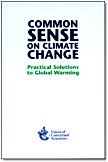 Common Sense on Climate Change: Practical Solutions to Global Warming - Our climate is changing as humans add large amounts of heat-trapping gases to the atmosphere. If we start now, we can avoid the worst outcomes—devastating sea level rise, more intense and longer droughts, more frequent and severe flooding. Practical solutions exist today to address this problem. Read this booklet and learn how you can make a difference. UCS, 2002. 14 pp. $4.00. PDF available for download -- click Common Sense on Climate Change: Practical Solutions to Global Warming - Our climate is changing as humans add large amounts of heat-trapping gases to the atmosphere. If we start now, we can avoid the worst outcomes—devastating sea level rise, more intense and longer droughts, more frequent and severe flooding. Practical solutions exist today to address this problem. Read this booklet and learn how you can make a difference. UCS, 2002. 14 pp. $4.00. PDF available for download -- click
here.
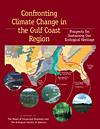
Confronting Climate Change in the Gulf Coast Region: Prospects for Sustaining our Ecological Heritage
by Robert Twilley et al
Climate change will magnify the human stresses already degrading Gulf Coast ecosystems. This report identifies the ecological consequences—those already under way and those likely to occur over the next century—so that policymakers and the public can act now to safeguard the region's natural heritage and its economy. UCS, 2001. 75 pp. $20.00.
Read the executive summary (pdf), the full report (pdf), or download by chapter. State summaries (Alabama, Florida, Louisiana, Mississippi, and Texas) also available.

 Confronting Climate Change in the Gulf Coast Confronting Climate Change in the Gulf Coast
Region -- Curriculum Guide (pdf)
Created especially for teachers and educators this guide is designed to complement the report and to make its findings accessible to younger residents of the Gulf Coast states. Helps transform climate change from an abstract concept to a real phenomenon with tangible effects on peoples' lives.
If you are having difficulties downloading the materials, you may place an order for a CD-ROM or a set of paper copies. Please contact Jean Sideris at ssi@ucsusa.org or at (617) 547-5552 for more information.
 Global Warming: Early Warning Signs - Poster-sized (2' x 3') world map depicting indicators of global climate change such as sea-level rise, melting glaciers, heat waves, floods, and shifting plant and animal ranges. UCS (in conjunction with six other environmental groups), 1999. Visit the Global Warming: Early Warning Signs website to see the interactive online map feature. Global Warming: Early Warning Signs - Poster-sized (2' x 3') world map depicting indicators of global climate change such as sea-level rise, melting glaciers, heat waves, floods, and shifting plant and animal ranges. UCS (in conjunction with six other environmental groups), 1999. Visit the Global Warming: Early Warning Signs website to see the interactive online map feature.
Linking Solutions to Climate Change and Biodiversity Loss
through the Kyoto Protocol's Clean Development Mechanism - Challenges and opportunities for projects to support climate stability, biodiversity conservation, and sustainable development objectives in developing countries. By Peter C. Frumhoff, Darren Goetze, and Jared Hardner. UCS, 1998. 14 pp. $6.00
Read the full report (pdf)
 A Small Price to Pay: US Action to Curb Global Warming Is Feasible and Affordable - Proof that meeting the 7 percent reduction in greenhouse-gas emissions mandated by the Kyoto Protocol will cost the United States little. By UCS and Tellus Institute. UCS, 1998. 17 pp. $6.00 A Small Price to Pay: US Action to Curb Global Warming Is Feasible and Affordable - Proof that meeting the 7 percent reduction in greenhouse-gas emissions mandated by the Kyoto Protocol will cost the United States little. By UCS and Tellus Institute. UCS, 1998. 17 pp. $6.00
Read the full report (pdf)
Scientific Integrity
Fredom to Speak? A Report Card on Federal Agency Media Policies - UCS conducted an investigation of 15 federal regulatory and science agencies to assess the degree of freedom with which science is communicated at federal agencies. The report found significant inconsistencies and confusion among agency media policies and their implementation. Too often, an agency's desire to "control the message" has led to the suppression of information and the censorship of the government's own experts. Read the full report online.
Interference at the EPA: Science and Politics at the U.S. Environmental Protection Agency - A UCS survey of scientists at the EPA reveals that challenges from industry lobbyists and some political leaders have led to the suppression and distortion of EPA scientific findings—to the detriment of both science and the health of our nation. 2008, 80 pp. $20.00. Read the executive summary and full report.

 Atmosphere of Pressure: Political Interference in Federal Climate Science - This report presents the results of two complementary investigations into the state of federal climate science, which show that scientific findings are being tailored to reflect political goals rather than scientific fact. By Timothy Donaghy et al. UCS and Government Accountability Project, 2007. 80 pp. $20.00. Read the executive summary and full report. Atmosphere of Pressure: Political Interference in Federal Climate Science - This report presents the results of two complementary investigations into the state of federal climate science, which show that scientific findings are being tailored to reflect political goals rather than scientific fact. By Timothy Donaghy et al. UCS and Government Accountability Project, 2007. 80 pp. $20.00. Read the executive summary and full report.

Clean Energy
 Coal Power in a Warming World - UCS's new report, Coal Power in a Warming World, examines the pros and cons of a proposed technology that would capture coal plant carbon dioxide emissions and store them underground. UCS supports construction of five to 10 full-scale demonstration projects to test carbon-capture-and-storage technology's ability to cut emissions. The report also says no new coal plants should be built that do not capture and store carbon emissions. Read the full report online. Coal Power in a Warming World - UCS's new report, Coal Power in a Warming World, examines the pros and cons of a proposed technology that would capture coal plant carbon dioxide emissions and store them underground. UCS supports construction of five to 10 full-scale demonstration projects to test carbon-capture-and-storage technology's ability to cut emissions. The report also says no new coal plants should be built that do not capture and store carbon emissions. Read the full report online.
 Walking a Nuclear Tightrope: Unlearned Lessons of Year-plus Reactor Outages - This report identifies common themes among extended nuclear power reactor outages and outlines steps the Nuclear Regulatory Commission should take to avoid a catastrophic (and avoidable) nuclear accident. By David Lochbaum. UCS, 2006. 39 pp. $10. Read the full report online. Walking a Nuclear Tightrope: Unlearned Lessons of Year-plus Reactor Outages - This report identifies common themes among extended nuclear power reactor outages and outlines steps the Nuclear Regulatory Commission should take to avoid a catastrophic (and avoidable) nuclear accident. By David Lochbaum. UCS, 2006. 39 pp. $10. Read the full report online.

 U.S. Nuclear Plants in the 21st Century: The Risk of a Lifetime - This report shows that aging U.S. nuclear power plants have an increased risk of serious accidents and that the Nuclear Regulatory Commission must adapt its regulatory regime to monitor plants at all points during their lifecycles. By David Lochbaum. UCS, 2004. 27 pp. $10.00. Read the executive summary and report online. U.S. Nuclear Plants in the 21st Century: The Risk of a Lifetime - This report shows that aging U.S. nuclear power plants have an increased risk of serious accidents and that the Nuclear Regulatory Commission must adapt its regulatory regime to monitor plants at all points during their lifecycles. By David Lochbaum. UCS, 2004. 27 pp. $10.00. Read the executive summary and report online.

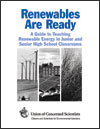 Renewables Are Ready: A Guide to Teaching Renewable Energy in Junior and Senior High School Classrooms - This newly revised and updated teacher's guide provides an ideal background for teaching a unit on renewable energy. It can be used to illustrate basic scientific principles and includes hands-on activities, games, action projects, and a resource guide. UCS, 2003. 89 pp. $10.00 (or $5.00 each for orders of 10 or more). Read the table of contents (PDF) or the full guide (PDF). Renewables Are Ready: A Guide to Teaching Renewable Energy in Junior and Senior High School Classrooms - This newly revised and updated teacher's guide provides an ideal background for teaching a unit on renewable energy. It can be used to illustrate basic scientific principles and includes hands-on activities, games, action projects, and a resource guide. UCS, 2003. 89 pp. $10.00 (or $5.00 each for orders of 10 or more). Read the table of contents (PDF) or the full guide (PDF).

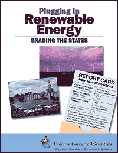 Plugging in Renewable Energy: Grading the States - This report assigns grades to each of the 50 states based on their commitment to supporting wind, solar, and other renewable energy sources. We measure commitment by the projected results of renewable electricity standards for electric companies and dedicated renewable electricity funds. UCS, 2003. 52 pp. $10.00. Also available is a 4 pp. fact sheet $5.00. Plugging in Renewable Energy: Grading the States - This report assigns grades to each of the 50 states based on their commitment to supporting wind, solar, and other renewable energy sources. We measure commitment by the projected results of renewable electricity standards for electric companies and dedicated renewable electricity funds. UCS, 2003. 52 pp. $10.00. Also available is a 4 pp. fact sheet $5.00.
Read the executive summary.
 Full Report Full Report
 Fact Sheet Fact Sheet
 Energy Security: Solutions to Protect America's Power Supply and Reduce Oil Dependence - The events of September 11, 2001, point unmistakably toward a new national priority: building a secure energy future. Clean and efficient technologies can cut oil dependence and reduce infrastructure vulnerability while saving consumers money and protecting the environment. Strong government action today will ensure that these technologies fulfill their promise of a safer, cheaper, and cleaner energy future. UCS, 2002. 19 pp. $10.00. Read the full report (pdf). Energy Security: Solutions to Protect America's Power Supply and Reduce Oil Dependence - The events of September 11, 2001, point unmistakably toward a new national priority: building a secure energy future. Clean and efficient technologies can cut oil dependence and reduce infrastructure vulnerability while saving consumers money and protecting the environment. Strong government action today will ensure that these technologies fulfill their promise of a safer, cheaper, and cleaner energy future. UCS, 2002. 19 pp. $10.00. Read the full report (pdf).

 Clean Energy Blueprint: A Smarter National Energy Policy for Today and the Future - How consumers could save more than $440 billion between 2002 amd 2020, if a series of energy-efficiency and renewable energy policies recommended in the report were to become law. By Steven Clemmer, Deborah Donovan, Alan Nogee, and Jeff Deyette. UCS, 2001. 52 pp. $10.00 Clean Energy Blueprint: A Smarter National Energy Policy for Today and the Future - How consumers could save more than $440 billion between 2002 amd 2020, if a series of energy-efficiency and renewable energy policies recommended in the report were to become law. By Steven Clemmer, Deborah Donovan, Alan Nogee, and Jeff Deyette. UCS, 2001. 52 pp. $10.00
Read the executive summary (pdf) or the full report (pdf).

Clean Power Surge: Ranking the States - Many states have made recent commitments to renewable energy. This report identifies which states have taken the strongest measures. By Steven Clemmer, Bentham Paulos, and Alan Nogee. UCS, 2000. 24 pp. Read the executive summary (html) or the full report (pdf). Errata, July 2000 (html).
Nuclear Plant Risk Studies: Failing the Grade - Describes the flaws that riddle assessments of risk at nuclear power plants. By David Lochbaum. UCS, 2000. 25 pp. $5.00
Read the executive summary (html) or the full report (pdf).

 Powerful Solutions: Seven Ways to Switch America to Renewable Electricity - Seven practical measures to switch America to renewable electricity sources: renewable portfolio standards, public benefits funding, net metering, fair transmission and distribution rules, fair pollution rules, consumer information, and putting green customer demand to work. By Alan Nogee, Steven Clemmer, Bentham Paulos, and Brent Haddad. UCS, 1999. 53 pp. $10.00 Powerful Solutions: Seven Ways to Switch America to Renewable Electricity - Seven practical measures to switch America to renewable electricity sources: renewable portfolio standards, public benefits funding, net metering, fair transmission and distribution rules, fair pollution rules, consumer information, and putting green customer demand to work. By Alan Nogee, Steven Clemmer, Bentham Paulos, and Brent Haddad. UCS, 1999. 53 pp. $10.00
Download by chapter (html) or read the full report(pdf).

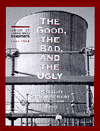 The Good, the Bad, and the Ugly: A Report on Safety in America's Nuclear Power Industry - Examination of safety margins at 10 representative nuclear power plants. By David Lochbaum. UCS, 1998. 20 pp. $6.00. The Good, the Bad, and the Ugly: A Report on Safety in America's Nuclear Power Industry - Examination of safety margins at 10 representative nuclear power plants. By David Lochbaum. UCS, 1998. 20 pp. $6.00.
Read the full report (pdf).

Renewing our Neighborhoods: Opportunities for Distributed Renewable Energy Technologies in the Boston Edison Service Area - How placing small renewable power systems on buildings in urban Boston would bring economic and environmental benefits. By Michael W. Tennis, Alan Nogee, Paul Jefferiss, and Ben Paulos. UCS, 1995. Read the executive summary (html).
Recipe for an Effective Campus Energy-Conservation Program - Description of the author's energy-conservation experiences at SUNY Buffalo with practical guidelines for establishing similar programs at colleges and other large institutions. By Walter Simpson. UCS, 1991. 17 pp.
Read the full report (PDF).
Clean Vehicles
 Delivering the Green: Reducing Trucks' Climate Impacts While Saving at the Pump - Technology available today can help reduce harmful emissions from tractor-trailers that cause global warming and smog. These off-the-shelf technologies have the added benefit of saving truckers money at the pump according to a new report, Delivering the Green, by UCS. Considering only products that are commercially available today, tractor-trailers can be equipped with aerodynamic devices and high-performance tires and wheels yielding a greater-than-12-percent reduction in fuel consumption. Read the full report. Delivering the Green: Reducing Trucks' Climate Impacts While Saving at the Pump - Technology available today can help reduce harmful emissions from tractor-trailers that cause global warming and smog. These off-the-shelf technologies have the added benefit of saving truckers money at the pump according to a new report, Delivering the Green, by UCS. Considering only products that are commercially available today, tractor-trailers can be equipped with aerodynamic devices and high-performance tires and wheels yielding a greater-than-12-percent reduction in fuel consumption. Read the full report.
 Setting the Standard: How Cost-Effective Technology Can Increase Vehicle Fuel Economy Setting the Standard: How Cost-Effective Technology Can Increase Vehicle Fuel Economy
The federal agency writing regulations for vehicle fuel economy standards could lay the groundwork for a new vehicle fleetwide average of more than 50 miles per gallon by 2030, according to a 2008 report from the Union of Concerned Scientists (UCS). The regulations mark the first phase of implementing standards passed by Congress in the energy bill in December 2007. Read the Full Report.
Biofuels: An Important Part of a Low-Carbon Diet
Expanded use of biofuels could cut global warming pollution, enhance our energy security, and strengthen local economies, but a new report by the Union of Concerned Scientists shows that not all biofuels are created equal. Any expansion of alternative fuel production must be accompanied by standards that account for each fuel's full global warming impact-in other words, the total heat-trapping emissions associated with a fuel over its entire life cycle (from the oil well, coal mine, or farm to the vehicle engine). $10. Read the full report (pdf).

 School Bus Pollution Report Card 2006: Grading the States – A state-by-state assessment of school bus pollution and cleanup efforts around the country. By Patricia Monahan. UCS, 2006. 69 pp. $10.00. Read the executive summary and full report (html). School Bus Pollution Report Card 2006: Grading the States – A state-by-state assessment of school bus pollution and cleanup efforts around the country. By Patricia Monahan. UCS, 2006. 69 pp. $10.00. Read the executive summary and full report (html).

Automaker Rankings 2007: The Environmental Performance of Car Companies - This report helps consumers and investors separate hype from reality by using government data to quantitatively determine which automakers truly are the greenest when the rubber meets the road. Read the executive summary and the full report.
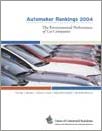 Automaker Rankings 2004: The Environmental Performance of Car Companies – $10.00. Read the executive summary and the full report. Automaker Rankings 2004: The Environmental Performance of Car Companies – $10.00. Read the executive summary and the full report.

 Sick of Soot: Reducing the Health Impacts of Diesel Pollution in California - This report highlights the impact of diesel pollution on public health in California and its potential impact during the next two decades. Existing "clean diesel" incentive programs and cost-effective retrofit technology on existing diesel engines could save thousands of lives and billions of dollars over the next 15 years. By Don Anair and Patricia Monahan. UCS, 2004. 54 pp. $15.00. Read the executive summary and download the full report. Sick of Soot: Reducing the Health Impacts of Diesel Pollution in California - This report highlights the impact of diesel pollution on public health in California and its potential impact during the next two decades. Existing "clean diesel" incentive programs and cost-effective retrofit technology on existing diesel engines could save thousands of lives and billions of dollars over the next 15 years. By Don Anair and Patricia Monahan. UCS, 2004. 54 pp. $15.00. Read the executive summary and download the full report.

 Climate Control: Global Warming Solutions for California Cars - Global warming emissions from California's vehicle fleet could be cut by 20 percent using existing technologies, with little additional cost to consumers. By Louise Bedsworth. UCS, 2004. pp. 48. Read the executive summary and the full report. Climate Control: Global Warming Solutions for California Cars - Global warming emissions from California's vehicle fleet could be cut by 20 percent using existing technologies, with little additional cost to consumers. By Louise Bedsworth. UCS, 2004. pp. 48. Read the executive summary and the full report.
 The Diesel Dilemma: Diesel's Role in the Race for Clean Cars - This report presents a new “apples-to-apples” comparison of diesel and gasoline technologies, applying each to the five major classes of passenger vehicles (small cars, larger “family” cars, sport utility vehicles, minivans, and pickup trucks). By Patricia Monahan and David Friedman. UCS, 2004. The Diesel Dilemma: Diesel's Role in the Race for Clean Cars - This report presents a new “apples-to-apples” comparison of diesel and gasoline technologies, applying each to the five major classes of passenger vehicles (small cars, larger “family” cars, sport utility vehicles, minivans, and pickup trucks). By Patricia Monahan and David Friedman. UCS, 2004.
68 pp. $10.00 Read the executive summary and the full report.

- This report shows how existing technologies can be used to offer consumers an SUV that is safer, cleaner, and more cost-effective, while retaining the size and performance SUV drivers have today.
By David Friedman. UCS, 2003. 38 pp. $10.00
See the special features and read the report.

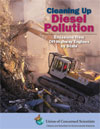 Cleaning Up Diesel Pollution: Emissions from Off-Highway Engines by State - This report shows how diesel engines in construction and farm equipment are a major source of air pollution. It also discusses the lagging emissions standards for these engines and describes how cost-effective technologies could be implemented as part of a comprehensive cleanup plan. By Patricia Monahan. UCS, 2003. 65 pp. $15.00 Cleaning Up Diesel Pollution: Emissions from Off-Highway Engines by State - This report shows how diesel engines in construction and farm equipment are a major source of air pollution. It also discusses the lagging emissions standards for these engines and describes how cost-effective technologies could be implemented as part of a comprehensive cleanup plan. By Patricia Monahan. UCS, 2003. 65 pp. $15.00
Read the executive summary (pdf) or the full report (2 MB pdf).

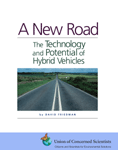 A New Road: The Technology and Potential of Hybrid Vehicles - This report provides consumers and policy-makers with the tools they will need to sort out the many technological, financial, and environmental differences among the hybrids that will be brought to market in the coming years. A New Road: The Technology and Potential of Hybrid Vehicles - This report provides consumers and policy-makers with the tools they will need to sort out the many technological, financial, and environmental differences among the hybrids that will be brought to market in the coming years.
By David Friedman. UCS, 2003. 70 pp. Read the executive summary or the full report (pdf)
- This report helps separate the hype from the hardware by using government data to quantitatively determine which automakers are the greenest based on the vehicles they actually sell in their showrooms.
By Jason Mark. UCS, 2002. 36 pp. Read the executive summary or the full report (pdf).
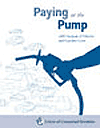 - This report calculates which of the nation's most popular cars will be the most expensive to drive in 2002. It also determines how much car owners could save at the pump if off-the-shelf technology which is capable of improving fuel economy by 30 percent for light trucks and by 27 percent for cars - were put to work. By David Friedman. UCS, 2002. 62 pp. Read the full report (pdf). - This report calculates which of the nation's most popular cars will be the most expensive to drive in 2002. It also determines how much car owners could save at the pump if off-the-shelf technology which is capable of improving fuel economy by 30 percent for light trucks and by 27 percent for cars - were put to work. By David Friedman. UCS, 2002. 62 pp. Read the full report (pdf).
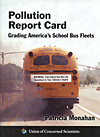 Pollution Report Card: Grading America's School Bus Fleets - This report assesses the pollution performance of state school bus fleets and gives them clean-air grades, ranging from "outstanding" to "failure." While the distribution of grades varies across the country, no states score as high as they might have because all of them rely upon high-polluting school buses, fueled primarily by diesel, to transport children. Cleaner alternatives exist today that can provide for our nation's children transportation that is both safe and clean. By Patricia Monahan. UCS, 2002. 67 pp. Read the executive summary (pdf) or the full report(pdf). Pollution Report Card: Grading America's School Bus Fleets - This report assesses the pollution performance of state school bus fleets and gives them clean-air grades, ranging from "outstanding" to "failure." While the distribution of grades varies across the country, no states score as high as they might have because all of them rely upon high-polluting school buses, fueled primarily by diesel, to transport children. Cleaner alternatives exist today that can provide for our nation's children transportation that is both safe and clean. By Patricia Monahan. UCS, 2002. 67 pp. Read the executive summary (pdf) or the full report(pdf).
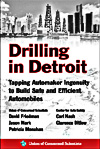
Drilling in Detroit: Tapping the Ingenuity of the Automaker Industry to Build Safe and Efficient Automobiles - A comprehensive exposition of the economic and environmental benefits of achieving a fuel-efficient fleet. By David Friedman et al. UCS, 2001. 117 pp. Read the executive summary (html) or the full report (2.5 mb pdf).
Over a Barrel: How to Avoid California's Second Energy Crisis - Explores the potential for a second energy crisis in California while offering potential solutions. By Julia Levin and Patricia Monahan UCS, 2001. 33pp. Read the executive summary (html) or read the full report (pdf).
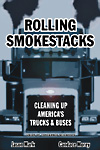
Rolling Smokestacks: Cleaning Up America's Trucks and Buses - Diesel engines on our highways, and the promise of new technologies to help clear the air. By Jason Mark and Candace Morey UCS, 2000. 68 pp. Read the executive summary (html) and download by chapter or read the full report (5 mb pdf).
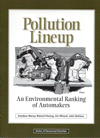 Pollution Lineup - How automakers stack up on pollution and what they can do to improve their standing. By Candace Morey, Roland Hwang, Jim Kliesch, and John DeCicco. UCS, 2000. 22 pp. Download the full report (pdf). Pollution Lineup - How automakers stack up on pollution and what they can do to improve their standing. By Candace Morey, Roland Hwang, Jim Kliesch, and John DeCicco. UCS, 2000. 22 pp. Download the full report (pdf).
Diesel Passenger Vehicles and the Environment - A detailed review of public-health and technological issues related to diesel passenger vehicles, including a critical perspective on the reintroduction of diesel into US markets for cars and light trucks. By Jason Mark and Candace Morey. UCS, 1999. For a print copy of the report, contact our Berkeley office.
Read the executive summary (html) or the full report:
Table of Contents (pdf)
Sections 1-3 (pdf)
Sections 4-5 (pdf)
References (pdf)
Greener SUVs: A Blueprint for Cleaner, More Efficient Light Trucks - How UCS engineers used affordable, existing technology to design a Ford Explorer that achieves 50 percent better mileage, pollutes 75 percent less and has a lower total cost. By Jason Mark. UCS, 1999. 28 pp.
Read the executive summary (html) or the full report:
Table of Contents (pdf)
Body of the Report (pdf)
Appendix A. Environmental Calculations (pdf)
Appendices B and C. Technical Analysis and References (pdf)
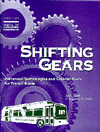 Shifting Gears: Advanced Technologies and Cleaner Fuels for Transit Buses - How electric, hybrid, and fuel-cell buses can take the market with a little help from policymakers. By Jason Mark and Laurence R. Davis. UCS, 1998. 37 pp. Shifting Gears: Advanced Technologies and Cleaner Fuels for Transit Buses - How electric, hybrid, and fuel-cell buses can take the market with a little help from policymakers. By Jason Mark and Laurence R. Davis. UCS, 1998. 37 pp.
An Equity Analysis of Pay-As-You-Drive Insurance in California - Analysis of the economic and environmental benefits of a pay-at-the-pump automobile insurance plan. By Jeff Allen, Roland Hwang, and Jane Kelly. UCS, 1994. 47 pp.
Steering a New Course: Transportation, Energy, and the Environment - Definitive analysis of transportation in America and its contribution to energy problems, including recommendations for a comprehensive transportation policy to reduce congestion, pollution, and oil dependence. By Deborah Gordon. Island Press, 1991. 244 pp.
Global Security
Toward True Security: Ten Steps the Next President Should Take to Transform U.S. Nuclear Weapons Policy - To prevent more nations—and eventually terrorists—from acquiring nuclear weapons, the United States should drastically reduce the role that nuclear weapons play in its security policies. Toward True Security outlines 10 steps the next president should take to transform U.S. nuclear policy. UCS, 2008. 31 pp. $10.00. Read the executive summary and the full report.

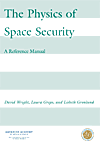
The Physics of Space Security: A Reference Manual - This AAAS report (written by UCS scientists) discusses the technical requirements for launching and maneuvering weapons in space and assesses the vulnerability of satellite components to interference or destruction. Its analysis provides the facts needed to make an informed evaluation of space policy choices. By David Wright, Laura Grego, and Lisbeth Gronlund. American Academy of Arts & Sciences, 2005. 177 pp. $15.00.
Read the report.

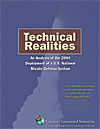 Technical Realities: An Analysis of the 2004 Deployment of a U.S. National Missile Defense System - This report shows that the planned deployment of the U.S. national missile defense will provide no real protection in an actual attack due to the lack of realistic testing. By Lisbeth Gronlund, David Wright, George Lewis, Philip Coyle III. UCS, 2004. 76 pp. $15.00. Read the executive summary and the full report. Technical Realities: An Analysis of the 2004 Deployment of a U.S. National Missile Defense System - This report shows that the planned deployment of the U.S. national missile defense will provide no real protection in an actual attack due to the lack of realistic testing. By Lisbeth Gronlund, David Wright, George Lewis, Philip Coyle III. UCS, 2004. 76 pp. $15.00. Read the executive summary and the full report.

 Countermeasures: A Technical Evaluation of the Operational Effectiveness of the Planned US National Missile Defense System - A detailed analysis of how the proposed national missile defense system could be defeated by missiles equipped with simple countermeasures. Demonstrates that any state technically capable of constructing missiles would also be able to construct effective countermeasures. By Andrew M. Sessler et al. UCS, 2000. 200 pp. $15.00 Countermeasures: A Technical Evaluation of the Operational Effectiveness of the Planned US National Missile Defense System - A detailed analysis of how the proposed national missile defense system could be defeated by missiles equipped with simple countermeasures. Demonstrates that any state technically capable of constructing missiles would also be able to construct effective countermeasures. By Andrew M. Sessler et al. UCS, 2000. 200 pp. $15.00
Read the executive summary (html) or the full report (pdf).

Beyond Safeguards: A Program for More Comprehensive Control of Weapon-Usable Fissile Material - Overview of international efforts to control access to highly enriched uranium and separated plutonium examines the adequacy of existing controls and proposes new measures that would strengthen the nonproliferation regime. By Lisbeth Gronlund and David Wright. UCS, 1994. 86 pp.
Food and Agriculture
CAFOs Uncovered: The High Cost of Confined Animal Operations - CAFOs (confined animal feeding operations) dominate U.S. meat and dairy production and causing major health and environmental problems. But current policies actually promote them at taxpayer expense. A new report-CAFOs Uncovered-explores these issues and recommends new policies. 2008. pp. $15.00. Read the executive summary and full report.

 Greener Pastures: How Grass-fed Beef and Milk Contribute to Healthy Eating - This report confirms that grass-fed beef is often leaner than the beef found on most supermarket shelves. In addition, beef and milk from animals raised entirely on pasture have higher levels than conventionally raised beef and dairy cattle of beneficial fats that may prevent heart disease and strengthen the immune system. By Kate Clancy. 87 pp. $15.00. Read the executive summary and full report. Greener Pastures: How Grass-fed Beef and Milk Contribute to Healthy Eating - This report confirms that grass-fed beef is often leaner than the beef found on most supermarket shelves. In addition, beef and milk from animals raised entirely on pasture have higher levels than conventionally raised beef and dairy cattle of beneficial fats that may prevent heart disease and strengthen the immune system. By Kate Clancy. 87 pp. $15.00. Read the executive summary and full report.

 The Economics of Pharmaceutical Crops: Potential Benefits and Risks for Farmers and Rural Communities - This report is the first analysis by a land-grant university economist of potential economic benefits and risks of pharmaceutical crops to farmers and rural America. UCS scientists conclude that proponents of pharmaceutical crops have inflated the rewards and downplayed the risks. Robert Wisner (technical report) and Margaret Mellon and Jane Rissler (UCS preface). UCS, 2005. 29 pp. $10. Read the full report. The Economics of Pharmaceutical Crops: Potential Benefits and Risks for Farmers and Rural Communities - This report is the first analysis by a land-grant university economist of potential economic benefits and risks of pharmaceutical crops to farmers and rural America. UCS scientists conclude that proponents of pharmaceutical crops have inflated the rewards and downplayed the risks. Robert Wisner (technical report) and Margaret Mellon and Jane Rissler (UCS preface). UCS, 2005. 29 pp. $10. Read the full report.

 A Growing Concern: Protecting the Food Supply in an Era of Pharmaceutical and Industrial Crops – This report presents the findings of a 2003 expert workshop on protecting the U.S. food supply from contamination by crops engineered to produce pharmaceuticals and industrial chemicals. The report includes an executive summary of UCS's conclusions and policy recommendations. By David Andow et al. (Technical Report) and Margaret Mellon and Jane Rissler (UCS Executive Summary). 125 pp. $20.00. Read the executive summary and full report. A Growing Concern: Protecting the Food Supply in an Era of Pharmaceutical and Industrial Crops – This report presents the findings of a 2003 expert workshop on protecting the U.S. food supply from contamination by crops engineered to produce pharmaceuticals and industrial chemicals. The report includes an executive summary of UCS's conclusions and policy recommendations. By David Andow et al. (Technical Report) and Margaret Mellon and Jane Rissler (UCS Executive Summary). 125 pp. $20.00. Read the executive summary and full report.

 Gone to Seed: Transgenic Contaminants in the Traditional Seed Supply - Seeds of traditional crops are contaminated with DNA from genetically engineered (GE) crops according to Gone to Seed, a new UCS report. Laboratory testing of traditional (non-GE) seeds of corn, soybeans, and canola commissioned by UCS documents the presence of DNA commonly used in commercial GE crops. These findings suggest inadequate federal standards to protect our seed supply and our food from harmful contaminants like those originating in pharmaceutical (pharm) and industrial crops. Gone to Seed: Transgenic Contaminants in the Traditional Seed Supply - Seeds of traditional crops are contaminated with DNA from genetically engineered (GE) crops according to Gone to Seed, a new UCS report. Laboratory testing of traditional (non-GE) seeds of corn, soybeans, and canola commissioned by UCS documents the presence of DNA commonly used in commercial GE crops. These findings suggest inadequate federal standards to protect our seed supply and our food from harmful contaminants like those originating in pharmaceutical (pharm) and industrial crops.
By Margaret Mellon and Jane Rissler. UCS, 2004. 80 pp. $15.00
See the web feature, download the executive summary, and full report.

  Hogging It: Estimates of Antimicrobial Abuse in Livestock - The use of antimicrobials in animal agriculture is eroding physicians' ability to treat infectious disease in humans. This report provides the first estimate based on a transparent methodology of the amount of antimicrobials given to animals for nontherapeutic purposes, such as promoting growth. The amount is enormous, dwarfing the quantity of antimicrobials in human medicine. By Margaret Mellon, Charles Benbrook, and Karen Lutz Benbrook. UCS, 2001. 110 pp. $15.00 Hogging It: Estimates of Antimicrobial Abuse in Livestock - The use of antimicrobials in animal agriculture is eroding physicians' ability to treat infectious disease in humans. This report provides the first estimate based on a transparent methodology of the amount of antimicrobials given to animals for nontherapeutic purposes, such as promoting growth. The amount is enormous, dwarfing the quantity of antimicrobials in human medicine. By Margaret Mellon, Charles Benbrook, and Karen Lutz Benbrook. UCS, 2001. 110 pp. $15.00
Read the executive summary (html) or the full report ...
Executive Summary (pdf) ... Chapters (pdf) ... Appendices (pdf) ... References (pdf)

 Now or Never: Serious New Plans to Save a Natural Pest Control - Outline of the necessary components of effective resistance management plans for corn, cotton, and potato crops that have been genetically engineered to produce the Bacillus thuringiensis toxin. Edited by Margaret Mellon and Jane Rissler. UCS, 1998. 150 pp. $14.95 Now or Never: Serious New Plans to Save a Natural Pest Control - Outline of the necessary components of effective resistance management plans for corn, cotton, and potato crops that have been genetically engineered to produce the Bacillus thuringiensis toxin. Edited by Margaret Mellon and Jane Rissler. UCS, 1998. 150 pp. $14.95

Read the full report:
Table of Contents (pdf)
1. UCS Introduction (pdf)
2. Contributors' Introduction (pdf)
3. Bt-Corn Resistance Management (pdf)
4. Bt-Cotton Resistance Management (pdf)
5. Bt-Potato Resistance Management (pdf)
Appendices (pdf)
A. Bt Crops Approved for Field Testing by USDA, 1987-1997
B. Microbial Bt Insecticide Use in US Crop Production, by Crop and State, 1992
C. Microbial Bt Insecticide Use in US Crop Production, by Crop, 1992
The Ecological Risks of Engineered Crops - Comprehensive look at the potential risks of genetically engineered crops, including recommendations on how the federal government can evaluate and mitigate those risks. By Jane Rissler and Margaret Mellon. MIT Press, 1996. 192 pp. $19.95

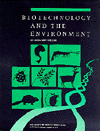 Biotechnology and the Environment - Useful primer on the environmental implications of genetic engineering, with a clear explanation of the uses and risks of modern genetic techniques. By Margaret Mellon. National Wildlife Federation, 1988. 64 pp. $5.00. Biotechnology and the Environment - Useful primer on the environmental implications of genetic engineering, with a clear explanation of the uses and risks of modern genetic techniques. By Margaret Mellon. National Wildlife Federation, 1988. 64 pp. $5.00.

Biodiversity
 Invasive Species in Ohio - A new UCS report finds that invasive species such as the emerald ash borer and zebra mussel already are causing significant damage in the state of Ohio. While the total cost of these non-native species is currently estimated at hundreds of millions of dollars a year, preventive legislation could significantly limit their economic and environmental impact. Invasive Species in Ohio - A new UCS report finds that invasive species such as the emerald ash borer and zebra mussel already are causing significant damage in the state of Ohio. While the total cost of these non-native species is currently estimated at hundreds of millions of dollars a year, preventive legislation could significantly limit their economic and environmental impact.
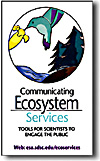 
Communicating Ecosystem Services: Tools for Scientists to Engage the Public - Valuable tools for scientists and others engaged in informing the public and policy-makers about the importance of maintaining healthy ecosystems and protecting our biological resources. Each tool kit provides background information—such as factsheets, case studies, and a policy overview—and tips for effective communication with the public, the media, and legislators. Also available from the project website. UCS, ESA, 2000. Water Purification 52 pp. Pollination 49 pp. $8.00 for one, $12 for both. Coming soon: Forest Carbon Storage and Flood Damage Control.
Linking Solutions to Climate Change and Biodiversity Loss
through the Kyoto Protocol's Clean Development Mechanism - Challenges and opportunities for projects to support climate stability, biodiversity conservation, and sustainable development objectives in developing countries. By Peter C. Frumhoff, Darren Goetze, and Jared Hardner. UCS, 1998. 14 pp. $6.00
Read the full report (pdf)
Logging Off: Mechanisms to Stop or Prevent Industrial Logging in Forests of High Conservation Value - The first broad assessment of the potential tools available for nongovernmental organizations (NGOs), governments, and other stakeholders to reduce or eliminate industrial logging in high conservation value forests. By Ted Gullison, Mary Melnyk, and Carmen Wong. UCS, 2001. 96 pp. $10.00
Read the full report (pdf)
Setting Priorities for Conserving Biological Diversity in Tropical Timber Production Forests - Alternative vision of how to protect the extraordinarily rich biological diversity of tropical timber forests. By Peter C. Frumhoff and Elizabeth C. Losos. UCS, 1998. 14 pp. $6.00
Read the full report (pdf)
Meeting the Challenges of Population, Environment, and Resources -- The Cost of Inaction - Collection of essays by highly respected scientists on the major environmental, resource, and population issues facing humanity. The World Bank, 1996. 46 pp. $5.00
Population Complications - In-depth discussion of alternative viewpoints in the debate over the social and environmental impacts of population growth, with strategies for reducing population growth rates. By Michael Brower. UCS, 1994. 20 pp. $4.00
|



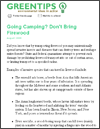
 2009 Scientific Integrity Calendar - In early 2008, hundreds of Americans entered Science Idol: the Scientific Integrity Editorial Cartoon Contest. UCS worked with some of America’s leading cartoonists to select just twelve finalists—reproduced in the 2009 scientific integrity calendar.
2009 Scientific Integrity Calendar - In early 2008, hundreds of Americans entered Science Idol: the Scientific Integrity Editorial Cartoon Contest. UCS worked with some of America’s leading cartoonists to select just twelve finalists—reproduced in the 2009 scientific integrity calendar.

 Nuclear Power in a Warming World
Nuclear Power in a Warming World

 The Consumer's Guide to Effective Environmental Choices: Practical Advice from the Union of Concerned Scientists - The first comprehensive look at the full range of modern consumer activities, identifying those that cause the most environmental damage and those that cause the least. By Michael Brower and Warren Leon. Three Rivers Press, 1999. 304 pp. $15.00.
The Consumer's Guide to Effective Environmental Choices: Practical Advice from the Union of Concerned Scientists - The first comprehensive look at the full range of modern consumer activities, identifying those that cause the most environmental damage and those that cause the least. By Michael Brower and Warren Leon. Three Rivers Press, 1999. 304 pp. $15.00. A Scientist's Guide to Talking with the Media
A Scientist's Guide to Talking with the Media A Distant Light: Scientists and Public Policy - Essays illuminating the challenges facing scientists who choose to be actively involved in public matters, with keen insights on what it takes to succeed. By Henry W. Kendall. Springer-Verlag, 2000. 336 pp. $49.95.
A Distant Light: Scientists and Public Policy - Essays illuminating the challenges facing scientists who choose to be actively involved in public matters, with keen insights on what it takes to succeed. By Henry W. Kendall. Springer-Verlag, 2000. 336 pp. $49.95. Keeping the Earth: Religious and Scientific Perspectives on the Environment - Inspirational video with prominent scientists and religious leaders calling on Americans to protect our environment and the diverse species that share it. UCS, 1996. 27 minutes, DVD. $14.95.
Keeping the Earth: Religious and Scientific Perspectives on the Environment - Inspirational video with prominent scientists and religious leaders calling on Americans to protect our environment and the diverse species that share it. UCS, 1996. 27 minutes, DVD. $14.95.  Smoke, Mirrors and Hot Air: How ExxonMobil Uses Big Tobacco's Tactics to Manufacture Uncertainty on Climate Science - This report uncovers the many tactics the oil giant has used to fuel doubt about global warming and delay federal action on climate solutions. By Seth Shulman. UCS, 2007. 63 pp. $10.
Smoke, Mirrors and Hot Air: How ExxonMobil Uses Big Tobacco's Tactics to Manufacture Uncertainty on Climate Science - This report uncovers the many tactics the oil giant has used to fuel doubt about global warming and delay federal action on climate solutions. By Seth Shulman. UCS, 2007. 63 pp. $10.  The Northeast Climate Impacts Assessment (NECIA) is a collaboration between the Union of Concerned Scientists and a team of independent experts using state-of-the-art tools to assess how global warming will affect the Northeast United States following two different paths: A higher emissions path with continued rapid growth in global warming pollution, and a lower emissions path with greatly reduced heat trapping emissions.
The Northeast Climate Impacts Assessment (NECIA) is a collaboration between the Union of Concerned Scientists and a team of independent experts using state-of-the-art tools to assess how global warming will affect the Northeast United States following two different paths: A higher emissions path with continued rapid growth in global warming pollution, and a lower emissions path with greatly reduced heat trapping emissions.
 Confronting Climate Change in the Great Lakes Region
Confronting Climate Change in the Great Lakes Region Common Sense on Climate Change: Practical Solutions to Global Warming - Our climate is changing as humans add large amounts of heat-trapping gases to the atmosphere. If we start now, we can avoid the worst outcomes—devastating sea level rise, more intense and longer droughts, more frequent and severe flooding. Practical solutions exist today to address this problem. Read this booklet and learn how you can make a difference. UCS, 2002. 14 pp. $4.00. PDF available for download -- click
Common Sense on Climate Change: Practical Solutions to Global Warming - Our climate is changing as humans add large amounts of heat-trapping gases to the atmosphere. If we start now, we can avoid the worst outcomes—devastating sea level rise, more intense and longer droughts, more frequent and severe flooding. Practical solutions exist today to address this problem. Read this booklet and learn how you can make a difference. UCS, 2002. 14 pp. $4.00. PDF available for download -- click

 Global Warming: Early Warning Signs - Poster-sized (2' x 3') world map depicting indicators of global climate change such as sea-level rise, melting glaciers, heat waves, floods, and shifting plant and animal ranges. UCS (in conjunction with six other environmental groups), 1999. Visit the
Global Warming: Early Warning Signs - Poster-sized (2' x 3') world map depicting indicators of global climate change such as sea-level rise, melting glaciers, heat waves, floods, and shifting plant and animal ranges. UCS (in conjunction with six other environmental groups), 1999. Visit the  A Small Price to Pay: US Action to Curb Global Warming Is Feasible and Affordable - Proof that meeting the 7 percent reduction in greenhouse-gas emissions mandated by the Kyoto Protocol will cost the United States little. By UCS and Tellus Institute. UCS, 1998. 17 pp. $6.00
A Small Price to Pay: US Action to Curb Global Warming Is Feasible and Affordable - Proof that meeting the 7 percent reduction in greenhouse-gas emissions mandated by the Kyoto Protocol will cost the United States little. By UCS and Tellus Institute. UCS, 1998. 17 pp. $6.00 Atmosphere of Pressure: Political Interference in Federal Climate Science - This report presents the results of two complementary investigations into the state of federal climate science, which show that scientific findings are being tailored to reflect political goals rather than scientific fact. By Timothy Donaghy et al. UCS and Government Accountability Project, 2007. 80 pp. $20.00.
Atmosphere of Pressure: Political Interference in Federal Climate Science - This report presents the results of two complementary investigations into the state of federal climate science, which show that scientific findings are being tailored to reflect political goals rather than scientific fact. By Timothy Donaghy et al. UCS and Government Accountability Project, 2007. 80 pp. $20.00.  Coal Power in a Warming World - UCS's new report, Coal Power in a Warming World, examines the pros and cons of a proposed technology that would capture coal plant carbon dioxide emissions and store them underground. UCS supports construction of five to 10 full-scale demonstration projects to test carbon-capture-and-storage technology's ability to cut emissions. The report also says no new coal plants should be built that do not capture and store carbon emissions.
Coal Power in a Warming World - UCS's new report, Coal Power in a Warming World, examines the pros and cons of a proposed technology that would capture coal plant carbon dioxide emissions and store them underground. UCS supports construction of five to 10 full-scale demonstration projects to test carbon-capture-and-storage technology's ability to cut emissions. The report also says no new coal plants should be built that do not capture and store carbon emissions.  Walking a Nuclear Tightrope: Unlearned Lessons of Year-plus Reactor Outages - This report identifies common themes among extended nuclear power reactor outages and outlines steps the Nuclear Regulatory Commission should take to avoid a catastrophic (and avoidable) nuclear accident. By David Lochbaum. UCS, 2006. 39 pp. $10.
Walking a Nuclear Tightrope: Unlearned Lessons of Year-plus Reactor Outages - This report identifies common themes among extended nuclear power reactor outages and outlines steps the Nuclear Regulatory Commission should take to avoid a catastrophic (and avoidable) nuclear accident. By David Lochbaum. UCS, 2006. 39 pp. $10.  U.S. Nuclear Plants in the 21st Century: The Risk of a Lifetime - This report shows that aging U.S. nuclear power plants have an increased risk of serious accidents and that the Nuclear Regulatory Commission must adapt its regulatory regime to monitor plants at all points during their lifecycles. By David Lochbaum. UCS, 2004. 27 pp. $10.00.
U.S. Nuclear Plants in the 21st Century: The Risk of a Lifetime - This report shows that aging U.S. nuclear power plants have an increased risk of serious accidents and that the Nuclear Regulatory Commission must adapt its regulatory regime to monitor plants at all points during their lifecycles. By David Lochbaum. UCS, 2004. 27 pp. $10.00.  Renewables Are Ready: A Guide to Teaching Renewable Energy in Junior and Senior High School Classrooms - This newly revised and updated teacher's guide provides an ideal background for teaching a unit on renewable energy. It can be used to illustrate basic scientific principles and includes hands-on activities, games, action projects, and a resource guide. UCS, 2003. 89 pp. $10.00 (or $5.00 each for orders of 10 or more). Read the
Renewables Are Ready: A Guide to Teaching Renewable Energy in Junior and Senior High School Classrooms - This newly revised and updated teacher's guide provides an ideal background for teaching a unit on renewable energy. It can be used to illustrate basic scientific principles and includes hands-on activities, games, action projects, and a resource guide. UCS, 2003. 89 pp. $10.00 (or $5.00 each for orders of 10 or more). Read the 
 Energy Security: Solutions to Protect America's Power Supply and Reduce Oil Dependence - The events of September 11, 2001, point unmistakably toward a new national priority: building a secure energy future. Clean and efficient technologies can cut oil dependence and reduce infrastructure vulnerability while saving consumers money and protecting the environment. Strong government action today will ensure that these technologies fulfill their promise of a safer, cheaper, and cleaner energy future. UCS, 2002. 19 pp. $10.00. Read the
Energy Security: Solutions to Protect America's Power Supply and Reduce Oil Dependence - The events of September 11, 2001, point unmistakably toward a new national priority: building a secure energy future. Clean and efficient technologies can cut oil dependence and reduce infrastructure vulnerability while saving consumers money and protecting the environment. Strong government action today will ensure that these technologies fulfill their promise of a safer, cheaper, and cleaner energy future. UCS, 2002. 19 pp. $10.00. Read the  Clean Energy Blueprint: A Smarter National Energy Policy for Today and the Future - How consumers could save more than $440 billion between 2002 amd 2020, if a series of energy-efficiency and renewable energy policies recommended in the report were to become law. By Steven Clemmer, Deborah Donovan, Alan Nogee, and Jeff Deyette. UCS, 2001. 52 pp. $10.00
Clean Energy Blueprint: A Smarter National Energy Policy for Today and the Future - How consumers could save more than $440 billion between 2002 amd 2020, if a series of energy-efficiency and renewable energy policies recommended in the report were to become law. By Steven Clemmer, Deborah Donovan, Alan Nogee, and Jeff Deyette. UCS, 2001. 52 pp. $10.00 Powerful Solutions: Seven Ways to Switch America to Renewable Electricity - Seven practical measures to switch America to renewable electricity sources: renewable portfolio standards, public benefits funding, net metering, fair transmission and distribution rules, fair pollution rules, consumer information, and putting green customer demand to work. By Alan Nogee, Steven Clemmer, Bentham Paulos, and Brent Haddad. UCS, 1999. 53 pp. $10.00
Powerful Solutions: Seven Ways to Switch America to Renewable Electricity - Seven practical measures to switch America to renewable electricity sources: renewable portfolio standards, public benefits funding, net metering, fair transmission and distribution rules, fair pollution rules, consumer information, and putting green customer demand to work. By Alan Nogee, Steven Clemmer, Bentham Paulos, and Brent Haddad. UCS, 1999. 53 pp. $10.00 The Good, the Bad, and the Ugly: A Report on Safety in America's Nuclear Power Industry - Examination of safety margins at 10 representative nuclear power plants. By David Lochbaum. UCS, 1998. 20 pp. $6.00.
The Good, the Bad, and the Ugly: A Report on Safety in America's Nuclear Power Industry - Examination of safety margins at 10 representative nuclear power plants. By David Lochbaum. UCS, 1998. 20 pp. $6.00. Delivering the Green: Reducing Trucks' Climate Impacts While Saving at the Pump -
Delivering the Green: Reducing Trucks' Climate Impacts While Saving at the Pump -  Setting the Standard: How Cost-Effective Technology Can Increase Vehicle Fuel Economy
Setting the Standard: How Cost-Effective Technology Can Increase Vehicle Fuel Economy School Bus Pollution Report Card 2006: Grading the States – A state-by-state assessment of school bus pollution and cleanup efforts around the country. By Patricia Monahan. UCS, 2006. 69 pp. $10.00.
School Bus Pollution Report Card 2006: Grading the States – A state-by-state assessment of school bus pollution and cleanup efforts around the country. By Patricia Monahan. UCS, 2006. 69 pp. $10.00.  Automaker Rankings 2004: The Environmental Performance of Car Companies – $10.00.
Automaker Rankings 2004: The Environmental Performance of Car Companies – $10.00.  Sick of Soot: Reducing the Health Impacts of Diesel Pollution in California - This report highlights the impact of diesel pollution on public health in California and its potential impact during the next two decades. Existing "clean diesel" incentive programs and cost-effective retrofit technology on existing diesel engines could save thousands of lives and billions of dollars over the next 15 years. By Don Anair and Patricia Monahan. UCS, 2004. 54 pp. $15.00.
Sick of Soot: Reducing the Health Impacts of Diesel Pollution in California - This report highlights the impact of diesel pollution on public health in California and its potential impact during the next two decades. Existing "clean diesel" incentive programs and cost-effective retrofit technology on existing diesel engines could save thousands of lives and billions of dollars over the next 15 years. By Don Anair and Patricia Monahan. UCS, 2004. 54 pp. $15.00.  Climate Control: Global Warming Solutions for California Cars - Global warming emissions from California's vehicle fleet could be cut by 20 percent using existing technologies, with little additional cost to consumers. By Louise Bedsworth. UCS, 2004. pp. 48.
Climate Control: Global Warming Solutions for California Cars - Global warming emissions from California's vehicle fleet could be cut by 20 percent using existing technologies, with little additional cost to consumers. By Louise Bedsworth. UCS, 2004. pp. 48.  The Diesel Dilemma: Diesel's Role in the Race for Clean Cars - This report presents a new “apples-to-apples” comparison of diesel and gasoline technologies, applying each to the five major classes of passenger vehicles (small cars, larger “family” cars, sport utility vehicles, minivans, and pickup trucks). By Patricia Monahan and David Friedman. UCS, 2004.
The Diesel Dilemma: Diesel's Role in the Race for Clean Cars - This report presents a new “apples-to-apples” comparison of diesel and gasoline technologies, applying each to the five major classes of passenger vehicles (small cars, larger “family” cars, sport utility vehicles, minivans, and pickup trucks). By Patricia Monahan and David Friedman. UCS, 2004. Building a Better SUV: A Blueprint for Saving Lives, Money, and Gasoline
Building a Better SUV: A Blueprint for Saving Lives, Money, and Gasoline Cleaning Up Diesel Pollution: Emissions from Off-Highway Engines by State - This report shows how diesel engines in construction and farm equipment are a major source of air pollution. It also discusses the lagging emissions standards for these engines and describes how cost-effective technologies could be implemented as part of a comprehensive cleanup plan. By Patricia Monahan. UCS, 2003. 65 pp. $15.00
Cleaning Up Diesel Pollution: Emissions from Off-Highway Engines by State - This report shows how diesel engines in construction and farm equipment are a major source of air pollution. It also discusses the lagging emissions standards for these engines and describes how cost-effective technologies could be implemented as part of a comprehensive cleanup plan. By Patricia Monahan. UCS, 2003. 65 pp. $15.00 A New Road: The Technology and Potential of Hybrid Vehicles - This report provides consumers and policy-makers with the tools they will need to sort out the many technological, financial, and environmental differences among the hybrids that will be brought to market in the coming years.
A New Road: The Technology and Potential of Hybrid Vehicles - This report provides consumers and policy-makers with the tools they will need to sort out the many technological, financial, and environmental differences among the hybrids that will be brought to market in the coming years.  Automaker Rankings: The Environmental Performance of Car Companies
Automaker Rankings: The Environmental Performance of Car Companies
 Pollution Report Card: Grading America's School Bus Fleets - This report assesses the pollution performance of state school bus fleets and gives them clean-air grades, ranging from "outstanding" to "failure." While the distribution of grades varies across the country, no states score as high as they might have because all of them rely upon high-polluting school buses, fueled primarily by diesel, to transport children. Cleaner alternatives exist today that can provide for our nation's children transportation that is both safe and clean. By Patricia Monahan. UCS, 2002. 67 pp. Read the
Pollution Report Card: Grading America's School Bus Fleets - This report assesses the pollution performance of state school bus fleets and gives them clean-air grades, ranging from "outstanding" to "failure." While the distribution of grades varies across the country, no states score as high as they might have because all of them rely upon high-polluting school buses, fueled primarily by diesel, to transport children. Cleaner alternatives exist today that can provide for our nation's children transportation that is both safe and clean. By Patricia Monahan. UCS, 2002. 67 pp. Read the 

 Pollution Lineup - How automakers stack up on pollution and what they can do to improve their standing. By Candace Morey, Roland Hwang, Jim Kliesch, and John DeCicco. UCS, 2000. 22 pp. Download the
Pollution Lineup - How automakers stack up on pollution and what they can do to improve their standing. By Candace Morey, Roland Hwang, Jim Kliesch, and John DeCicco. UCS, 2000. 22 pp. Download the  Shifting Gears: Advanced Technologies and Cleaner Fuels for Transit Buses - How electric, hybrid, and fuel-cell buses can take the market with a little help from policymakers. By Jason Mark and Laurence R. Davis. UCS, 1998. 37 pp.
Shifting Gears: Advanced Technologies and Cleaner Fuels for Transit Buses - How electric, hybrid, and fuel-cell buses can take the market with a little help from policymakers. By Jason Mark and Laurence R. Davis. UCS, 1998. 37 pp.
 Technical Realities: An Analysis of the 2004 Deployment of a U.S. National Missile Defense System - This report shows that the planned deployment of the U.S. national missile defense will provide no real protection in an actual attack due to the lack of realistic testing. By Lisbeth Gronlund, David Wright, George Lewis, Philip Coyle III. UCS, 2004. 76 pp. $15.00. Read the
Technical Realities: An Analysis of the 2004 Deployment of a U.S. National Missile Defense System - This report shows that the planned deployment of the U.S. national missile defense will provide no real protection in an actual attack due to the lack of realistic testing. By Lisbeth Gronlund, David Wright, George Lewis, Philip Coyle III. UCS, 2004. 76 pp. $15.00. Read the  Countermeasures: A Technical Evaluation of the Operational Effectiveness of the Planned US National Missile Defense System - A detailed analysis of how the proposed national missile defense system could be defeated by missiles equipped with simple countermeasures. Demonstrates that any state technically capable of constructing missiles would also be able to construct effective countermeasures. By Andrew M. Sessler et al. UCS, 2000. 200 pp. $15.00
Countermeasures: A Technical Evaluation of the Operational Effectiveness of the Planned US National Missile Defense System - A detailed analysis of how the proposed national missile defense system could be defeated by missiles equipped with simple countermeasures. Demonstrates that any state technically capable of constructing missiles would also be able to construct effective countermeasures. By Andrew M. Sessler et al. UCS, 2000. 200 pp. $15.00 Greener Pastures: How Grass-fed Beef and Milk Contribute to Healthy Eating - This report confirms that grass-fed beef is often leaner than the beef found on most supermarket shelves. In addition, beef and milk from animals raised entirely on pasture have higher levels than conventionally raised beef and dairy cattle of beneficial fats that may prevent heart disease and strengthen the immune system. By Kate Clancy. 87 pp. $15.00.
Greener Pastures: How Grass-fed Beef and Milk Contribute to Healthy Eating - This report confirms that grass-fed beef is often leaner than the beef found on most supermarket shelves. In addition, beef and milk from animals raised entirely on pasture have higher levels than conventionally raised beef and dairy cattle of beneficial fats that may prevent heart disease and strengthen the immune system. By Kate Clancy. 87 pp. $15.00.  The Economics of Pharmaceutical Crops: Potential Benefits and Risks for Farmers and Rural Communities - This report is the first analysis by a land-grant university economist of potential economic benefits and risks of pharmaceutical crops to farmers and rural America. UCS scientists conclude that proponents of pharmaceutical crops have inflated the rewards and downplayed the risks. Robert Wisner (technical report) and Margaret Mellon and Jane Rissler (UCS preface). UCS, 2005. 29 pp. $10.
The Economics of Pharmaceutical Crops: Potential Benefits and Risks for Farmers and Rural Communities - This report is the first analysis by a land-grant university economist of potential economic benefits and risks of pharmaceutical crops to farmers and rural America. UCS scientists conclude that proponents of pharmaceutical crops have inflated the rewards and downplayed the risks. Robert Wisner (technical report) and Margaret Mellon and Jane Rissler (UCS preface). UCS, 2005. 29 pp. $10.  A Growing Concern: Protecting the Food Supply in an Era of Pharmaceutical and Industrial Crops – This report presents the findings of a 2003 expert workshop on protecting the U.S. food supply from contamination by crops engineered to produce pharmaceuticals and industrial chemicals. The report includes an executive summary of UCS's conclusions and policy recommendations. By David Andow et al. (Technical Report) and Margaret Mellon and Jane Rissler (UCS Executive Summary). 125 pp. $20.00.
A Growing Concern: Protecting the Food Supply in an Era of Pharmaceutical and Industrial Crops – This report presents the findings of a 2003 expert workshop on protecting the U.S. food supply from contamination by crops engineered to produce pharmaceuticals and industrial chemicals. The report includes an executive summary of UCS's conclusions and policy recommendations. By David Andow et al. (Technical Report) and Margaret Mellon and Jane Rissler (UCS Executive Summary). 125 pp. $20.00.  Gone to Seed: Transgenic Contaminants in the Traditional Seed Supply - Seeds of traditional crops are contaminated with DNA from genetically engineered (GE) crops according to Gone to Seed, a new UCS report. Laboratory testing of traditional (non-GE) seeds of corn, soybeans, and canola commissioned by UCS documents the presence of DNA commonly used in commercial GE crops. These findings suggest inadequate federal standards to protect our seed supply and our food from harmful contaminants like those originating in pharmaceutical (pharm) and industrial crops.
Gone to Seed: Transgenic Contaminants in the Traditional Seed Supply - Seeds of traditional crops are contaminated with DNA from genetically engineered (GE) crops according to Gone to Seed, a new UCS report. Laboratory testing of traditional (non-GE) seeds of corn, soybeans, and canola commissioned by UCS documents the presence of DNA commonly used in commercial GE crops. These findings suggest inadequate federal standards to protect our seed supply and our food from harmful contaminants like those originating in pharmaceutical (pharm) and industrial crops.
 Now or Never: Serious New Plans to Save a Natural Pest Control - Outline of the necessary components of effective resistance management plans for corn, cotton, and potato crops that have been genetically engineered to produce the Bacillus thuringiensis toxin. Edited by Margaret Mellon and Jane Rissler. UCS, 1998. 150 pp. $14.95
Now or Never: Serious New Plans to Save a Natural Pest Control - Outline of the necessary components of effective resistance management plans for corn, cotton, and potato crops that have been genetically engineered to produce the Bacillus thuringiensis toxin. Edited by Margaret Mellon and Jane Rissler. UCS, 1998. 150 pp. $14.95 Biotechnology and the Environment - Useful primer on the environmental implications of genetic engineering, with a clear explanation of the uses and risks of modern genetic techniques. By Margaret Mellon. National Wildlife Federation, 1988. 64 pp. $5.00.
Biotechnology and the Environment - Useful primer on the environmental implications of genetic engineering, with a clear explanation of the uses and risks of modern genetic techniques. By Margaret Mellon. National Wildlife Federation, 1988. 64 pp. $5.00. Invasive Species in Ohio - A new UCS report finds that invasive species such as the emerald ash borer and zebra mussel already are causing significant damage in the state of Ohio. While the total cost of these non-native species is currently estimated at hundreds of millions of dollars a year, preventive legislation could significantly limit their economic and environmental impact.
Invasive Species in Ohio - A new UCS report finds that invasive species such as the emerald ash borer and zebra mussel already are causing significant damage in the state of Ohio. While the total cost of these non-native species is currently estimated at hundreds of millions of dollars a year, preventive legislation could significantly limit their economic and environmental impact.
